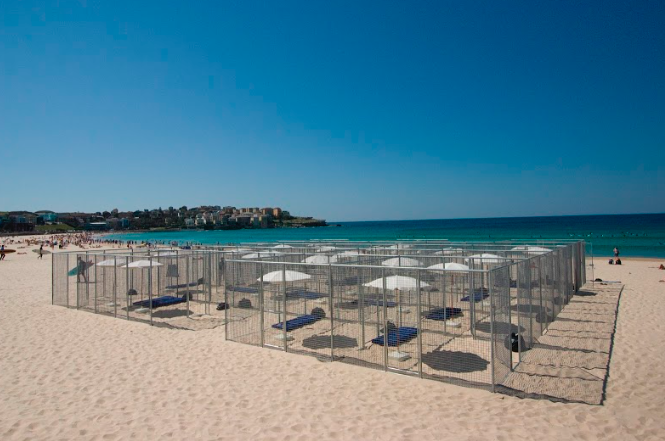by Ian Milliss

Ian Milliss is an artist who worked on Wrapped Coast.
This article is a companion piece to Wendy Bacon & Judith Pugh’s articles, check them out below:
Wendy Bacon: ‘Suburban Battlers who Changed the World‘
Judith Pugh: ‘Anzac and the Other’
Image credit: Kaldor Public Art Project 16: Gregor Schneider. 21 beach cells, Bondi Beach, Sydney, 28 September – 21 October 2007. © Gregor Schneider. Photo: Gregor Schneider
Until Kaldor Public Art Projects came along most of the public art in Australia took the form of memorials of one sort or another designed to preserve the memory of a person or event. It was a starkly instrumental view of art that valued it mostly as a reference to something else rather than something to be admired in its own right. Even a sculpture as hypnotic as the Archibald Fountain (in Sydney’s Hyde Park) was actually intended as a war memorial commemorating the relationship between Australia and France in the First World War.
Memorials can have complex meanings that change over time. What exactly should we remember? Memorials exclude as much as they include, and who decides who is included? As Judith Pugh notes in her essay, often the historical events that are memorialised are less important than the social power displayed by creating the memorials, disguising meanings that are not immediately apparent.
While the Kaldor Projects seemed to be simply staging radical art of a sort rarely seen previously in Australia, they also implicitly represented the influence of post Second World War immigration and the rise of multiculturalism. The radicalism of the projects reflected John Kaldor’s grounding in full blooded European modernism, at a time when most Australian art still reflected the more insipid and timid British version of modernism.
Nonetheless, several of the projects deal directly with memorialisation. The most obvious is Project 19, Tatzu Nishi’s War and peace and in between (2009) where the heroic equestrian sculptures at the front of the Art Gallery of NSW were captured within suburban rooms. The overscaled earnestness of the bronze horses has always felt wrong for their location, and the uncomfortable militarism of The Offerings of War became farcical when trapped in a domestic bedroom. The Offerings of Peace on the other hand seemed puzzled by the mundane bourgeois soft furnishings of a modernist living room. Both were proof that the bombast of memorials can be easily punctured.
A very different type of memorialisation, via re-enactment, can be seen in the refugee cages of Project 16, Gregor Schneider’s 21 Beach Cells on Bondi Beach in 2007. The 4 x 4 metre cells contained amenities for visitors – an air mattress, beach umbrella and black plastic garbage bag – and were soon inhabited by beachgoers looking for a site to rest and find shelter from the sun. But the cells were reminiscent of Australia’s Manus Regional Processing Centre, a concentration camp for refugees opened in 2001, giving the whole work a sinister edge as beach goers using the cages unwittingly acted out the racist claims that the camps were tropical Edens, a virtual holiday resort.
War memorials are the most common memorials in Australia yet the most important war is never mentioned. The European invasion and the genocidal war on Australia’s Indigenous owners is at the heart of Project 32, Jonathan Jones barrangal dyara (skin and bones). If the memorial halls that Judith Pugh discusses can be seen as assertions of the invaders’ control of Country, Jonathan Jones brings that hidden history back into view. Part of this remembering happens through remaking, in the form of 15,000 shields that represent the destroyed artifacts that had been stored in the Garden Palace building.
It could be argued that an exhibition such as Making Art Public, made from archival material relating to a series of events, is a form of memorial, a memory of events rather than the events themselves. But the final memorial is a memorial of the exhibition itself. I’m thinking of Alicia Frankovich’s performance The Work (2019) in which original workers on Kaldor projects over the last half-century revisited fragments of their own activities in a complex and playful choreographed re-enactment.
This all raises the question of how we memorialise important events in contemporary society. Kellys Bush is a public reserve close to John Kaldor’s home. As the first Green Ban, Kellys Bush represents a cultural moment as significant in its way as Wrapped Coast, and one with even greater worldwide consequences, yet this significance is barely recognised at the site. Wendy Bacon’s archival investigation notes that there are only two small pieces of signage about the history of the area. This way of marking history is clearly inadequate, since the battle for Kellys Bush was arguably the small spark that triggered a worldwide movement. The tourist Petra Kelly learned of the Green Bans while visiting Australia in the early 1970s and was inspired to form the first Green Party on her return to Germany. That party began the green parliamentary movement around the world. How could we better memorialise the small suburban inspiration of such an enormously influential movement?

